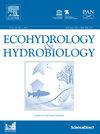Effects of the El Niño 2015/2016 event on Acartia tonsa and A. lilljeborgii (Copepoda) production in a Brazilian Amazon estuary
IF 2.7
4区 环境科学与生态学
Q2 ECOLOGY
引用次数: 0
Abstract
Studies that estimate the biomass and production of zooplankton organisms in estuaries are essential to understanding the flow of energy in these ecosystems, which are of extreme ecological, social, and economic importance. Therefore, the aim of the present study was to estimate the effects of the anomalous climatic event El Niño 2015/2016 on the production dynamics of Acartia tonsa and Acartia lilljeborgii in a small Amazon estuary. Data on hydrological variables (temperature, salinity, turbidity, and chlorophyll-a) and zooplankton organisms were collected during ten field campaigns from June 2014 to September 2016. In 2015 and 2016, during the El Niño event, annual rainfall levels were lower than the historical average. Salinity also exhibited significant variations, with the highest values observed during El Niño (> 36 during the dry season). A. lilljeborgii showed a greater tolerance to higher salinity values compared to its counterpart; however, biomass and production values were affected when salinity exceeded 36. These results demonstrate that extreme events, such as El Niño, can have serious consequences in small estuaries like Taperaçu, influencing the population dynamics of planktonic organisms, especially copepods, and consequently, the entire trophic chain. This makes this environment highly vulnerable to these climate changes.
2015/2016 年厄尔尼诺现象对巴西亚马逊河河口桡足类(Acartia tonsa 和 A. lilljeborgii)产量的影响
估算河口浮游动物生物的生物量和产量的研究对于了解这些生态系统中的能量流动至关重要,这对生态、社会和经济都具有重要意义。因此,本研究的目的是评估El Niño 2015/2016异常气候事件对亚马逊河口小河口tonsa和Acartia lilljeborgii生产动态的影响。2014年6月至2016年9月,通过10次野外调查收集了水文变量(温度、盐度、浊度和叶绿素-a)和浮游动物生物的数据。2015年和2016年,在厄尔Niño事件期间,年降雨量低于历史平均水平。盐度也表现出显著的变化,El Niño (>;旱季时为36条)。与同类相比,拟南芥对较高盐度值的耐受性更强;当盐度超过36时,生物量和产值受到影响。这些结果表明,极端事件,如El Niño,可以对像taperau这样的小河口产生严重后果,影响浮游生物,特别是桡足类生物的种群动态,从而影响整个营养链。这使得这里的环境极易受到气候变化的影响。
本文章由计算机程序翻译,如有差异,请以英文原文为准。
求助全文
约1分钟内获得全文
求助全文
来源期刊

Ecohydrology & Hydrobiology
Agricultural and Biological Sciences-Aquatic Science
CiteScore
5.40
自引率
3.80%
发文量
51
期刊介绍:
Ecohydrology & Hydrobiology is an international journal that aims to advance ecohydrology as the study of the interplay between ecological and hydrological processes from molecular to river basin scales, and to promote its implementation as an integrative management tool to harmonize societal needs with biosphere potential.
 求助内容:
求助内容: 应助结果提醒方式:
应助结果提醒方式:


